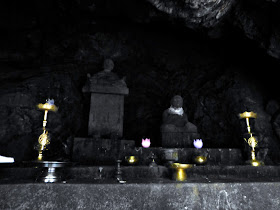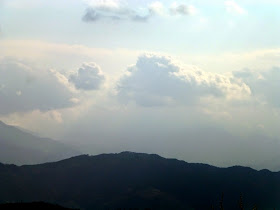It's second fiddle to Mount Fuji. It's much shorter. It's not really that beautiful by itself. But Mount Takao is a great day trip outside of Tokyo city, yet still in Tokyo's jurisdiction.
I missed the cherry blossoms in my area over the last couple weeks. I saw them from the train or in passing a few times, but I never stopped to enjoy the petals. Luckily Mount Takao is high enough that the season is delayed by a week or two, and the petals were just starting to fall on Monday.
There are a few trees around the base of the mountain, near the train station.
There's a nice rose tree too, and it had several flowers on it.
You're going to see a lot of flowers in this post. Just accept that fact.
This is the big tree that I took close-up photos of, above. There's an Italian restaurant next to the station and since my friend was starving we went there to eat before starting our hike up the mountain. The food was okay, especially if you are really hungry. There are probably more restaurants in the area, but we didn't see anything really obvious; plan on eating a good breakfast before leaving Tokyo and having a large dinner afterwards. I'll talk a little bit more about food later on.
White flower.
Yellow flower. You follow a small stream (somewhat visible behind the yellow flower) for a couple minutes to the trailheads.
These signs essentially mark the start of the hike. There are several options to get up and down the mountain. Just beyond this point are two modes of transportation that will get you about halfway up the hill: a cable car and a chair lift.
The area at the bottom of the mountain is pretty nice, with this garden-like rest area; there's a row of souvenir shops across the small street.
Let's talk about trail choices. Three trails lead from the base to the top of the mountain.
Trail 1 is the most popular and largest. The bottom half of the trail is relatively uneventful - just hiking up or down a mountain; this is the portion that can be bypassed with the cable car or chair lift. The rest of Trail 1 includes a monkey park, temple, and a few other sights; a large portion of Trail 1 is lined by small sculptures. There is a loop trail around the middle of the trail (Trail 2), and at this point it's possible to take Trail 3 or Trail 4 to the top.
Trail 6 heads up the left-hand side of the mountain, following a stream gully most of the way to the top. It's more of a nature trail than Trail 1, heading through a forest and offering lots of beautiful natural sights. At one point, near the top of the mountain, you follow a stone path right up the stream (which flows at a trickle in that area).
The third trail that goes from the base to the top is called the Inariyama Trail. It is just a little further "left" and follows one of the ridges that runs alongside Trail 6 and the stream. This path is especially worth hiking in early summer when hydrangeas and lilies are in bloom.
Trail 2's loop goes around the monkey park and garden, and takes about 30 minutes.
Trail 3 branches off to the left, following the ridge between Trail 6 and Trail 1. It faces south, so it has plants that grow in warmer climates; the trail also has three bridges and a giant cedar tree.
Trail 4, which heads up the northern side of the mountain, has a suspension bridge and a lot of shade, though it includes a very steep section near the top.
Trail 5 is another loop trail around the top of the mountain.
A final trail, found at the top of the mountain, is called the Mount Takao/Mount Jimba Trail. It's an 18.5 km trail that takes up to 7 hours to hike one way. It's possible to access Mt. Jimba or a couple other points along the trail with bus service, though I don't know anything about it.
I went up Trail 6, following the stream and avoiding the crowds.
Partway up the trail, there is a pair of caves with some religious artifacts.
A little further up, the trail splits, one part going up, the other down. Head down to visit the temple and waterfall; we should have gone back to check it out. You can then backtrack a short bit and continue up the mountain.
There are lots of very tall trees along the trails. Some of them are very old with hollow trunks or openings in their bases, among the roots.
Termites!
One of the bridges along Trail 6. They aren't spectacular, but they are named. This is Oyama Bridge.
As you get further up the hill, the trail crosses a couple feeder streams.
Exposed rocks in several places show that this area has seen a lot of volcanic activity, with upturned, flipped, and off-kilter stones.
We saw a couple birds in the bush, and heard some animals, including frogs, wild boar, and what must have been a raccoon of some sort. There are plenty of bugs, other birds, spiders, and snakes out here, too.
My friend ate a little bit of this. The old Japanese man who she thought told him to eat it was quite amused.
I'm not sure why I don't have pictures of the stones up the middle of the stream. But eventually we reached the top. The view was a bit hazy but enjoyable.
Mount Fuji is back there. I think you can see the outline through the clouds, though I'm not entirely sure. I'd like to visit again when it's visible.
Also not visible is Tokyo. It was warmer and somewhat cloudy, which couldn't have helped our chances. I've heard that the best time to visit is in January or February - in the snow!
There's a really large cherry tree at the top of the mountain with lots of blossoms on it. The sun was out, which really helped my photographs!
This is looking out toward Tokyo, but it's not visible in the photo.
The city you can see closest to the mountain is Hachioji.
I mentioned food; there are some places to get something to eat at the top. Everything was closed, or at least closing, by the time we got there, so I can't tell you anything about quality or selection. I was afraid of that happening, but my friend has a hard time keeping to a schedule and getting around on trains, and our late start getting to Takao and our extra delay by having a sit-down lunch meant we didn't get to the top until almost 4 PM.
We chose Trail 1 to hike down, so we could see some of the popular sights. The large temple complex is pretty impressive and has several levels as you head down (or up) the mountain.
You'll see this image in several places, especially on souvenirs in the stores. This is the larger tengu (demon-like being); there's also one with a beak.
Statues of the tengu inside the red gate (about 4 photos up) depict the beaked tengu...
And the long-nosed tengu.
There are lots of little shrines and buildings at this temple.
If I understand things correctly, you make a wish, walk through the stone ring, then pick up a stick and hit the rings on the pole behind the ring.
Here are two more statues of the tengu.
Another gate; this one has four guardians.
I only took photos of three.
Viewing the gate from the correct "entrance" side. Remember, I came from the top, so the pictures above are from back to front.
There are several very large trees near the temple, some of them extremely old. A typhoon knocked several over at some point.
At the halfway point, around where the Trail 2 loop is, there are some areas where you can see out toward Tokyo. Again, it couldn't be seen because of the haze and clouds.
The lower sun made for some nice colors and some cherry trees are visible in the mountains.
Here's the chair lift entrance halfway up the mountain (which would take you back to the bottom). It was closed when we arrived, but we weren't planning on taking it anyway.
By this point it was after 4:40 (I like that clock). We continued down the mountain but I didn't really see anything spectacular for the rest of the trip. We worked up an appetite going up and down the mountain so we grabbed dinner at Denny's in Shinjuku.
Mount Takao is easily accessed via the Keio Line - a rapid train goes directly to Takao-san-guchi Station every 20-30 minutes or so, with local trains running about every 10 minutes otherwise. It's possible to hike from JR Takao Station (a much further, less-popular option) as well. "Admission" to the mountain is completely free, and the Keio Line train fare from Shinjuku is under 400 yen each way.
If you want to use the cable car or ski-style lift, it's 470 yen one way or 900 yen round trip. The cable car runs from 8:00 every morning, ending some time between 17:00 and 18:30 depending on time of year and day of the week. I'm not sure about the lift times.












































































No comments:
Post a Comment